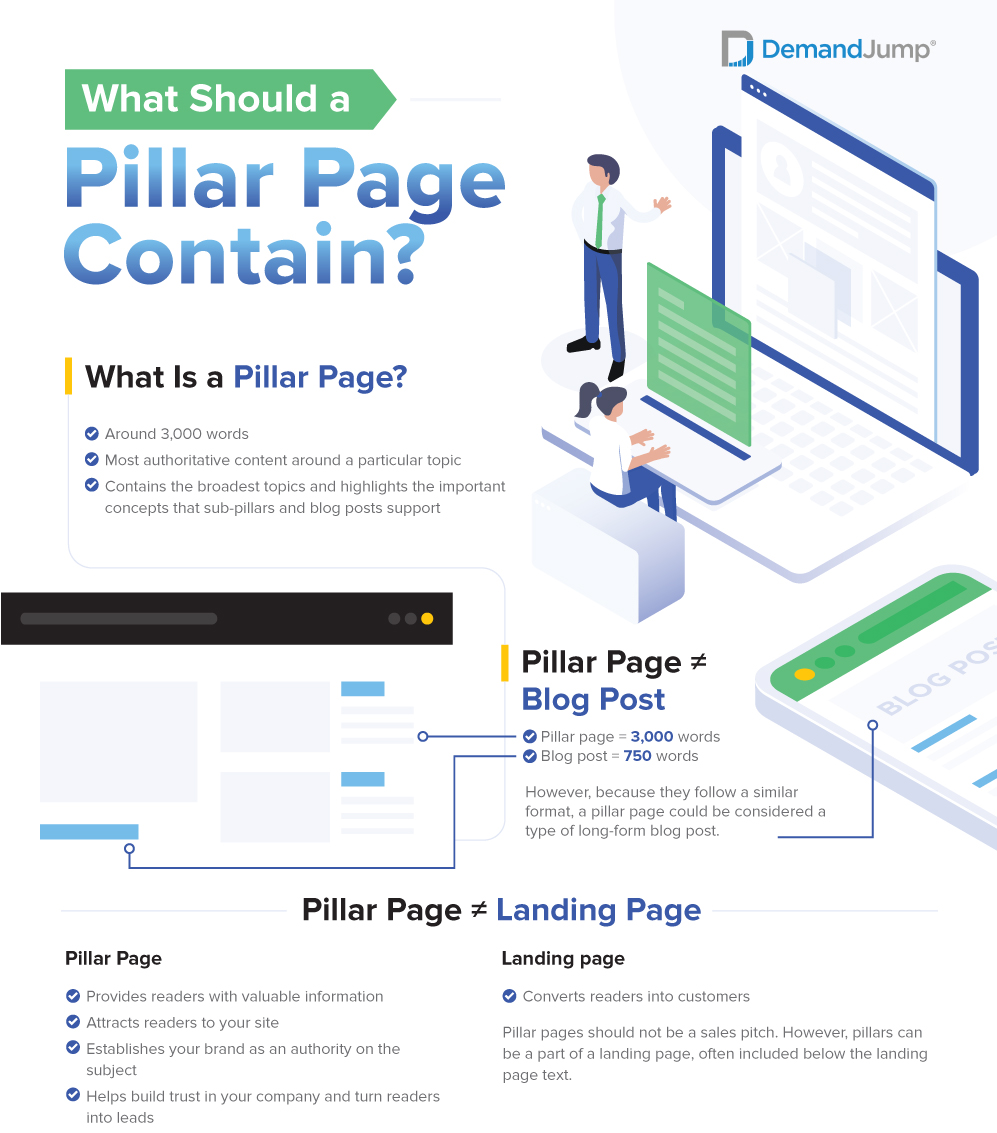How Do You Write a Pillar Page?
February 18, 2022 •Tamzin Walters

Have you heard the buzz about SEO Pillar pages? This approach to content marketing is helping people get on the first page of search engines in a short amount of time. Perhaps you’ve seen several pillar page examples and are excited to write your own. Here’s a short guide with all the info you need to get started. Let’s dive in!
What Are Pillar Pages?
Pillar pages are the central hub of a topic cluster, an SEO strategy to rank on a particular topic or content cluster. When writing a pillar page, SEO is important to keep in mind because, well, that’s the whole point! Pillar pages are typically around 3,000 words, with a few supporting pillars (around 1,800-2,000 words) and a host of blogs (around 750 words) all covering different facets of the topic you’ve chosen.

How Do I Choose a Pillar Page?
Picking your pillar page topic can feel overwhelming. After all, what makes a good pillar page? In our opinion, a good pillar page topic is:
- Related to Your Marketing Goals
Obviously, you want to choose a pillar that encompasses what your business does, but it’s important to be strategic about what facet you pick to highlight. Think about what wins you’re hoping to achieve with this content cluster—do you want to bring in new leads? Establish your brand as an authority on a topic? Educate your existing customers about your solutions? While pillar pages will naturally do a little bit of all of these things, picking your pillar topic strategically can help you accomplish your main goal or goals (spoiler alert: DemandJump can help you pick your topics!).
- Broad - But Not Too Broad
Don’t worry, we’re not going to go down the “Goldilocks” route to make this point (although it definitely works). Your pillar topic should be broad enough to merit having support pillars and blog posts, but not so broad that there’s no chance of getting your content on the first page. For example, a topic like “SaaS” is so broad, with so many different related keywords that it probably wouldn’t make a good pillar topic. However, “SaaS marketing platform” is more specific while still encompassing a lot of material and would make a better option for a pillar.
- Chock-full of Keywords
For your pillar to rank on search engines, you need to include high-value keywords and questions that are relevant to your topic. How do you find those keywords and questions? Thanks for asking! That’s basically our whole thing! Here at DemandJump, our entire platform is dedicated to making the process of finding and using keywords easy. Our consumer behavior insights uncover the most important keywords to include in your content and even help you pick out the topics to write about!
How Do You Write a Pillar Page?

After you’ve picked your topic, now comes the part where you have to actually put pen to paper… or more likely, fingers to keyboard. One of the major questions is, how do you structure a pillar page? Here are the steps to structure and write your pillar:
Create Your Pillar Page Outline
The best way to create an outline is by using keywords and questions that people ask about that topic (hint: you can get these easily by using a DemandJump outline). Set these as the H2s to create the sections of your pillar (make sure you set your title to the “title tag” or “H1”—and remember to do your tags in a hierarchical order, so H1, H2, H3, etc). One effective way to organize your outline is to start with the most general questions and then drill down into more specific ones. Be sure to pick 15-20 keywords and questions to include, since your pillar should be around 3,000 words. Each section will usually be about 200-300 words, so keep that in mind while picking your keywords.
For example, our SEO Keyword Research Pillar outline looks like this:
(Introduction)
What is keyword research in SEO?
Why keyword research is done in SEO
How do I find SEO keywords?
What is keyword research tool in SEO
SEO keywords examples
Keyword research tips
How to choose keywords for SEO
Can I do keyword research for free?
What is the best keyword research tool? (Conclusion/call to action)
Each of the middle sections is a commonly asked question about this topic or includes high-value keywords. They are all H2s.
Fill In the Middle Sections
Many people may think that starting with the introduction is the best place to start writing, but we actually recommend starting with the middle sections of your pillar. After all, you can’t introduce someone you’ve never met, right? So start with the “meat”—the part with the most valuable information. When researching and using different sources, make sure that you include proper citations by linking to where you found the information. You’ll also get more SEO value if you answer the H2 question in each section immediately with a short, succinct answer before explaining it further. This may also help you capture the “answer boxes” on search engines like Google.

Write a Conclusion and Introduction
After filling in the middle sections, write a conclusion with a strong call-to-action (some tangible step for the reader to take, like sign up for a free trial or fill out a contact form). Then add your intro (now that you’re thoroughly acquainted with the pillar!) to bring the reader into the article. This is a great place to add a story or statistic and set up the issue that your pillar is going to solve for the reader.

Check for Common Writing Errors
Once you’ve hit your word count, it’s time to go back and make sure your writing is engaging and error-free. Common things to check for are:
- Simple spelling and grammar errors
Be sure to run a simple spell check! Having other people in your organization read through your piece can also help catch little proofing errors.
- Formatting
Make sure that all your headings are set to “H2” or “H3,” etc. Look for odd spacing or places where your content could use a bulleted list or bold text to help the reader skim your content easily.
- Long rambling sentences
It’s important to keep your sentences concise so that readers don’t get lost in tangents. Look for places with long sentences or lots of clauses. Restructure those sentences to make your point clearer.
- Too much sales talk
People generally don’t like relentless sales pitches, so make sure that you’re not too heavy-handed with selling. After all, content marketing needs to have actual content—the valuable information that you’re sharing with your readers.
Ready to start writing your first pillar? With DemandJump’s one-click content outlines and revolutionary keyword research, we can help you reach your key audience in no time. (Below: an example of a CTA for ya!).
Featured Articles
Categories
- Attribution Tracking (13)
- Channel Optimization (11)
- Consumer Insights (68)
- Content Marketing (251)
- Data Science (8)
- Digital Marketing (6)
- Digital Transformation (26)
- Enterprise (10)
- Lead Generation (14)
- Market Intelligence (8)
- Marketing Analytics (39)
- Marketing Attribution (57)
- Marketing Management (153)
- Marketing Operations (86)
- Organic Search (222)
- Paid Search (52)
- Pillar-Based Marketing (63)
- Programmatic Advertising (9)
- SaaS Content (14)
- SaaS Marketing (29)
- Search Marketing (111)
- SEO Keyword Research (28)
- SEO Pillar (18)
- SEO Strategy (46)
- SMB (5)
- Website Content (12)


